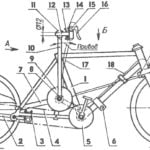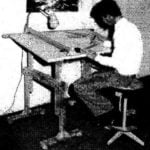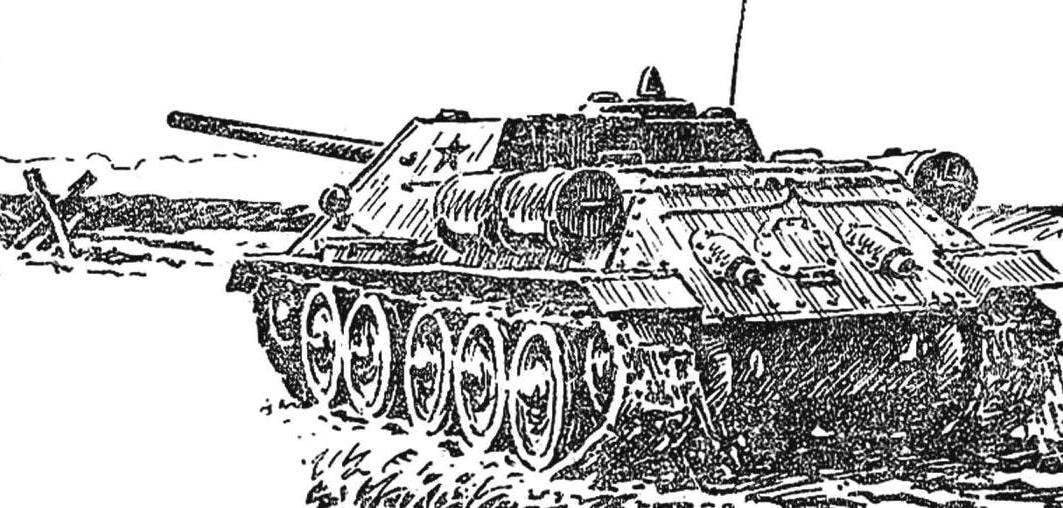Quick March of the artillery postarano occupied and camouflaged positions. Not knowing about the presence of the artillery reserves in this place, the enemy tanks entered the defense sector of the regiment. After letting them at 500— 600 m, battery team opened fire. For a few minutes immediately broke out a few smoky, smoldering fires. Tanks backed away, trying to get out of the zone of fire, to gun new self-propelled guns followed them all the way out. Armored vehicles tried to turn, but then froze, scorching armor-piercing projectiles. Losing 19 tanks, including several heavy” and a dozen armored personnel carriers, the enemy fell back to their positions.
At the storming of the city of Asinou in the East Prussian operation, valuable support to the infantry had 1294 th SAP. A large force of German infantry supported by assault guns, launched a counterattack against Soviet units. Two batteries of the regiment concentrated fire swept away the wolf enemy infantry. The enemy tried to flank him. Quickly moving to a new firing positions, artillery opened a withering fire on the infantry and assault guns of the enemy. After destroying six of them, gunners chastened counterattacking and forced them to go on the defensive.
In one of the reports about combat operations of the 1st guards tank army stated: “Ka all stages of the battle self-propelled artillery played an important role in supporting the actions of the troops. With the rapid onset, she, together with tanks relentlessly pursued the enemy, destroying its manpower and equipment. Possessing high mobility and heavy armor equal to modern tanks, self-propelled artillery established itself as the artillery of direct support tanks and infantry. In addition, self-propelled artillery was an effective means of defense.”
And as things were leading tank designer Nazi Germany Ferdinand Porsche? After all, the advertised “tigers” and “Panthers” and “ferdinands” were burning under the blows of tanks and self-propelled guns of Soviet production! In 1943 Germany undertook an almost complete rearmament of its armored forces, but the forces for conducting offensive in 1944 still was not enough. The Germans are beginning to produce new means of dealing with Soviet tanks: the 88-mm self-propelled anti-tank gun ka basis of a medium tank T-VI “Nashorn” (“Rhino”), a 128-mm gun, “yagd tiger” on the basis of the tank “tiger”, the 88-mm gun “yagd Panther” etc.
COMPARATIVE CHARACTERISTICS OF TANKS
By the end of the war, the production of self-propelled artillery in Nazi Germany even began to outpace the production of tanks. However, despite some promising design solutions, to bring their cars to perfection, to eliminate identified during the test and a battle defects Porsche did not have time: the war is inexorably approaching the borders of the Reich. In 1944 the factories Porsche appears symbiosis: the form of the body “Panther” gun and armor “Ferdinand” (“king tiger” T-VIБ). The thickness of the sheets in the frontal part of the tank was 100-150 mm, on the sides of 80 mm; frontal turret armor was up to 180mm and was considered impenetrable. It was thought that this machine had to make a change in the course of hostilities.
Porsche was so confident in his tank that he sent to the front with the first battalion of the “Royal tigers” ferry Porsche, his son, who worked with him. In the first battle the young Porsche was killed in battle with the thirty, and in a few days was broken and the whole battalion — not without the help of efficient SU-35.
However, even if Porsche managed to establish serial production of a huge 180-ton tank “Maus” (“mouse”) that had half the frontal armor, it would not have saved the Wehrmacht. After the SU-85 on the field of battle was even more powerful SU-100, ISU-122 and ISU-152.
The fate of the three “mice”, which managed to produce the factories of Porsche, was a foregone conclusion. One of them Soviet soldiers captured at the test site in Kummersdorf, the other was taken at the door rate under the Zossen, and the third at the entrance to the Reich Chancellery in Berlin.
A. BESKURNIKOV
Recommend to read
 “ROWING” DRIVE VELOMOBILE
“ROWING” DRIVE VELOMOBILE
Olympic games were held in Greece. I like venoconstrictor, pleased with the success of our riders on the track. And was impressed winning four rowers on academic Powerful boats, rowing... HOME DESK:
HOME DESK:
It happens, unfortunately, that the student no home of his Desk that he would be doing homework, playing, making. Meanwhile, the construction of such a table can be so simple that you...
 The victory of the Soviet troops in the forty-second and forty-third years had tipped the scales of war in our favor. The enemy got an object lesson. Failing two consecutive critical operations such as “Typhoon” and “the Citadel”, where the rate was in the tanks, after losing the battle of Stalingrad, in which Soviet armored vehicles went far not last role, the fascist command was forced to seriously attend to the problems of his tank.
The victory of the Soviet troops in the forty-second and forty-third years had tipped the scales of war in our favor. The enemy got an object lesson. Failing two consecutive critical operations such as “Typhoon” and “the Citadel”, where the rate was in the tanks, after losing the battle of Stalingrad, in which Soviet armored vehicles went far not last role, the fascist command was forced to seriously attend to the problems of his tank.